With the rapid advancement of technology, DDR5 memory sticks are emerging as the preferred choice for enhancing personal computer performance. Now is an opportune moment to upgrade or replace your PC with DDR5 memory, thanks to increasingly accessible market prices and the promise of unlocking unparalleled memory frequency and bandwidth potential. This translates into a significant boost in computer performance, whether you’re handling extensive data processing, navigating complex professional software, or immersing yourself in high-demand gaming environments.
Of particular note is the introduction of 24GB single DDR5 memory sticks, marking a substantial leap in memory capacity. They promise to deliver unprecedented smoothness and robust support for users across various computing needs.
Today, we delve into the TEAMGROUP T-FORCE XTREEM DDR5 memory modules. Specifically, I’ll be reviewing their XTREEM 2x24GB DDR5-7600 (CL 36-47-47-84) kit. These modules feature a sleek aluminum casing, boast a hefty 24GB capacity per module, and are compatible with Intel XMP 3.0 profiles. I’m eager to explore their performance capabilities, so let’s dive into today’s review!
Unboxing
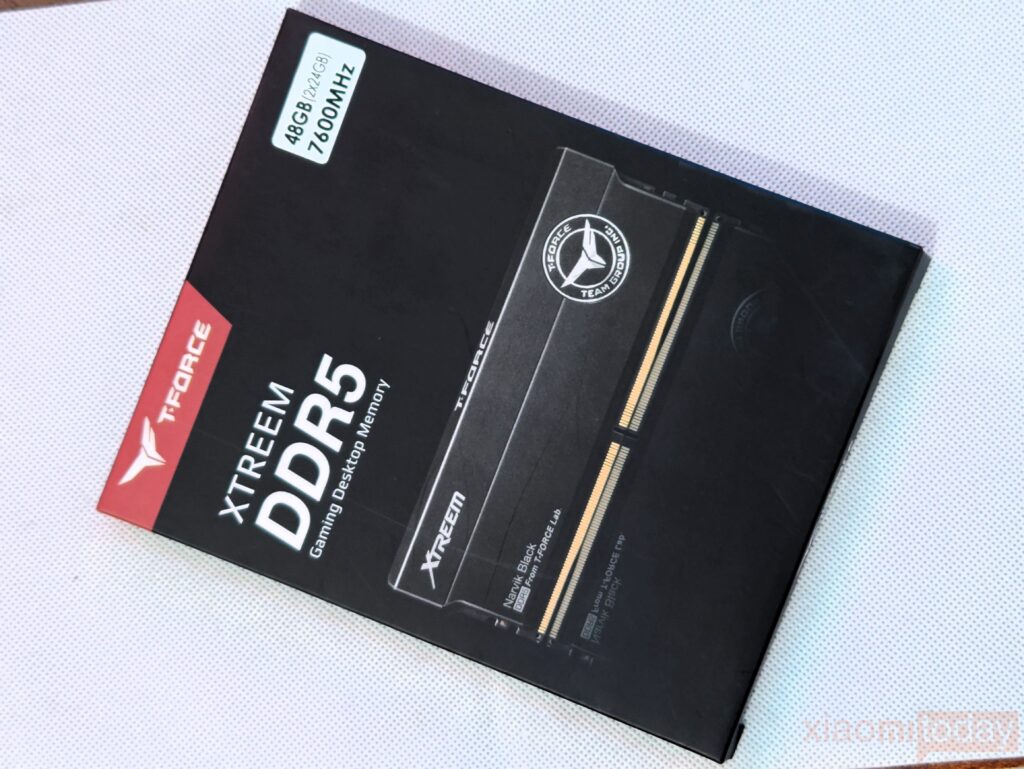
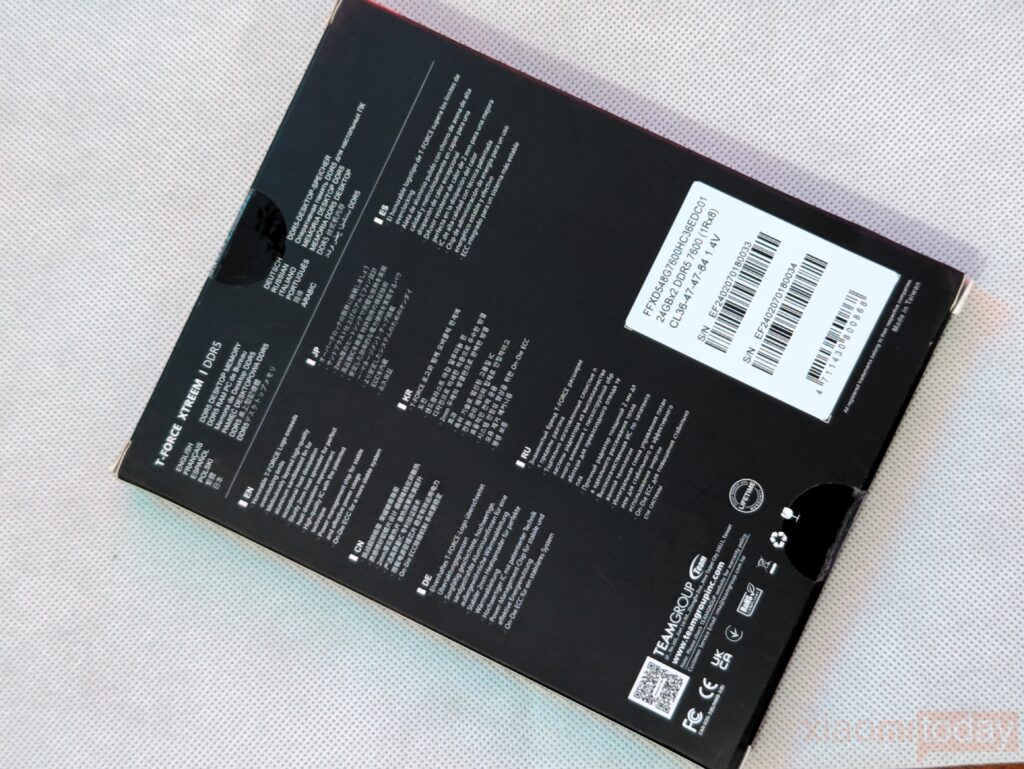
The outer packaging of the TEAMGROUP T-FORCE XTREEM DDR5 Memory indicates its XTREEM Series pedigree, designed for high-performance computer enthusiasts and gamers. Featuring a capacity of 48GB (24GBx2) and a clock speed of 7600MHz, it comes in a sleek black-toned carton with DDR5 printed prominently on the front alongside capacity and frequency details. The back of the box provides product descriptions and serial numbers in multiple languages.

Inside, the RAM kit is protected by a semi-rigid plastic blister, ensuring safe transit. The package contents include:
- T-FORCE XTREEM DDR5 RAM Kit
- Manufacturer’s Sticker
Closer Look

Let’s take a look at the design of the TEAMGROUP T-FORCE XTREEM DDR5 memory module. The aluminum heat dissipation fins offer a subtle yet textured appearance, adding a unique style during installation and matching. The heat sink surface features a black sandblasted texture, with a slanted top to enhance the air contact area of the aluminum fins for improved cooling efficiency.
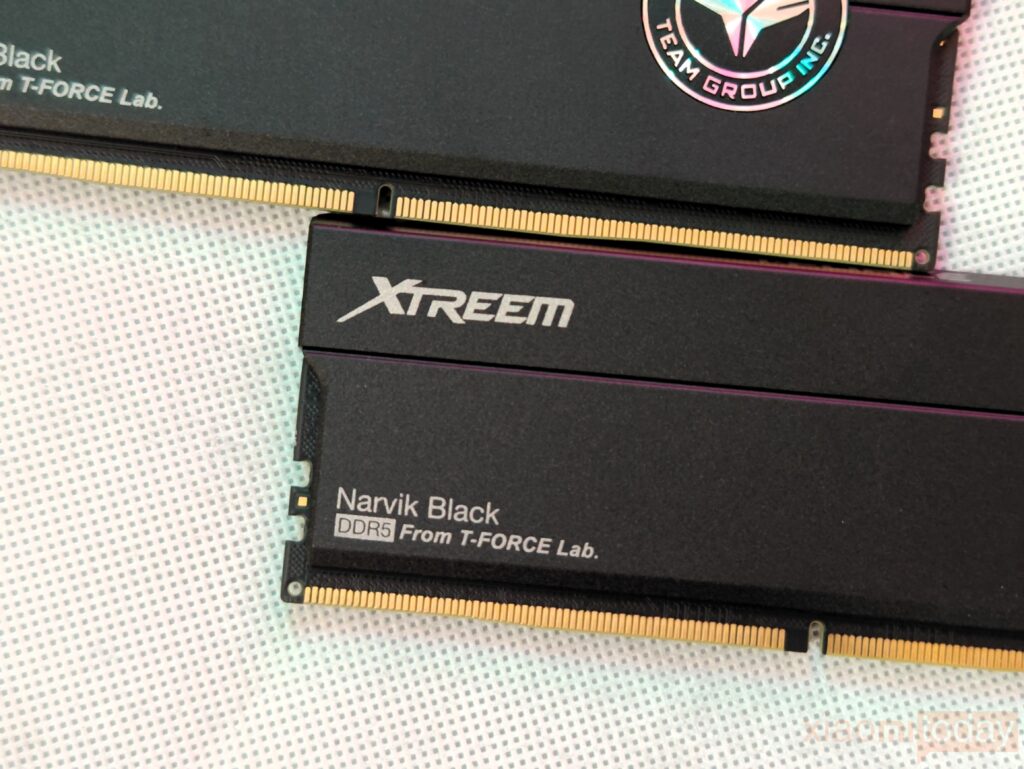


The Teamgroup T-Force Xtreem DDR5 memory module features a sleek design with the word “XTREEM” prominently laser-engraved on the front. On the right half of the module, a large TFORCE CNC badge signifies its premium status and its origins from the renowned T-FORCE Lab. This badge not only adds to the aesthetic appeal but also emphasizes the quality and craftsmanship associated with the T-FORCE brand. At the top of the sloping design is printed with the T-FORCE Logo, etc.


In addition, on the right side is the product badge design of TeamGroup T-Force. On the other side, you can see the heat dissipation fin design at the top, which uses an integrated design to connect with the memory particle heat sink below. This set of memory modules adopts a 1Rx8 single-sided configuration to provide the highest performance. From the side view of the T-FORCE XTREEM memory module, you can see that the contact surface with the memory particles/PMIC has thermally conductive silicone to connect and fix the heat dissipation fins.

The memory modules measure 48.8 x 134.5 x 8.2 millimeters. Their height warrants consideration for compatibility with your CPU cooling system, particularly for users with air cooling, though it generally doesn’t affect SLC owners. Notably, these modules lack RGB lighting, with the radiators fully focused on cooling. This design choice is logical given the declared frequencies and 1.45 V voltage, which many readers might see as an advantage.


After removing the heat sink, let me take a look at the internal materials of XTREEM DDR5. The memory particles use SK Hynix A-Die (H5CG48AGBD) particles, showcasing single-sided memory particles. These modules incorporate a high-quality integrated power management chip (PMIC) with a patented technique by the brand, ensuring high efficiency. Operating at 7600 MHz with a voltage of 1.4V, they demonstrate an impressive performance at this frequency.

The latency configuration for these modules is also quite aggressive, with CL36-47-47-84 timings. The 8200 MHz version operates at CL38-49-49-84 with a voltage of 1.4V, utilizing SK-Hynix chips. This highlights the module’s capability to maintain tight timings even at high frequencies, providing a balance between speed and latency.

The new non-binary RAM technology, such as the 2 x 24 GB configuration, offers notable advantages over traditional binary RAM. It allows for higher data storage density per cell, improving overall efficiency and enabling higher speeds in large modules. Internally, these modules maintain characteristics common to DDR5 RAM, including Dual Channel capacity with four 32-bit channels and a total of 40 bits per channel with On-Die ECC for enhanced system stability. The T-Force Xtreem DDR5 modules are compatible with Intel XMP 3.0 profiles and AMD EXPO, ensuring broad compatibility across different CPUs.
Performance Test
After installing the memory modules and activating the XMP profile, it’s crucial to check the operating voltage set by the motherboard for VDDQ and VCCSA. Sometimes, these values may be excessively high and unsafe. To achieve the full declared frequency, around 1.4V is typically needed for these parameters. However, this is only conditionally safe and not recommended for constant use. This suggests that while motherboards can handle these memory frequencies, they are not yet fully optimized for them. Improvements are expected in the future.


Using Thaiphoon Burner software, we examined the parameters of the TEAMGROUP T-FORCE XTREEM DDR5 memory and its components. The software revealed that these modules were produced between December 4-8, 2023, with memory chips manufactured by Hynix. The T-FORCE XTREEM DDR5 features an Intel XMP 3.0 profile with a frequency of 7600 MHz, a voltage of 1.40V, and timings of 36-47-47-84-131. In addition to supporting Intel XMP 3.0, it also supports AMD EXPO one-click overclocking.
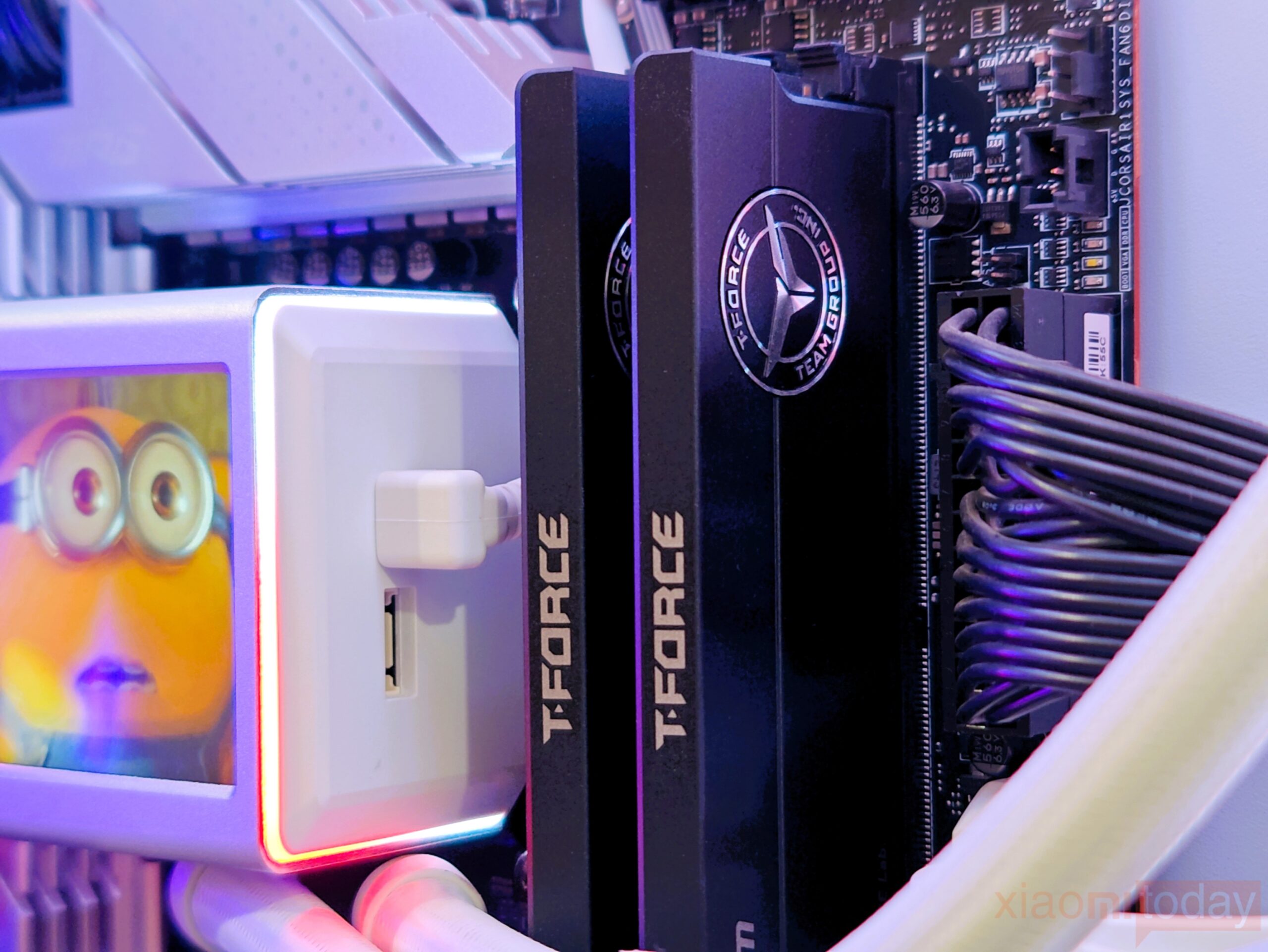
To understand the combat effectiveness of the TEAMGROUP T-FORCE XTREEM DDR5-7600 48GB Kit, we used the MSI MPG Z790 Edge TI MAX WiFi motherboard and the Intel® Core™ i7-13700K processor for actual testing. This setup allows us to evaluate the performance and overclocking capabilities of the memory modules. Before diving into the testing results, it is essential to clarify the specifications of the test system:
| Test Setup | |
|---|---|
| Motherboard | MSI MPG Z790 Edge TI MAX |
| Processor | Intel® Core™ i7-13700K |
| RAM Memory | T-FORCE XTREEM DDR5 – 7600MHz |
| Storage | Sabrent Rocket Q4 4TB NVMe SSD |
| Graphic Card | ASUS ROG Strix GeForce RTX 3080 OC Edition (10GB) |
| CPU Cooler | Lian Li GALAHAD II LCD AIO |
| Casing | Lian Li O11 Dynamic EVO XL Full Tower Case |
| Fan | 6x Lian Li UNI FAN SL-INF 120 RGB Fans |

In the BIOS of the MSI MPG Z790 Edge TI MAX motherboard, you can see that this set of memory modules has two built-in XMP profiles. To achieve the highest performance, select the XMP Profile 1 setting, which configures the memory to run at DDR5-7600 with timings of CL 36-47-47-84 at 1.4V. However, if your platform struggles with stability at this speed, you can opt for the XMP Profile 2 setting, which runs the memory at DDR5-6000 with timings of CL 38, providing a more stable alternative.
Let’s go to CPU-Z to check the platform-related information for the T-FORCE XTREEM DDR5-7600 Kit. On the SPD page, we can see that the T-FORCE XTREEM DDR5-7600 uses SK Hynix memory chips and supports the latest Intel XMP 3.0 one-click overclocking technology.

T-FORCE XTREEM DDR5-7600 memory uses high-quality SK Hynix A-Die particles, which are one of the best particles currently used in high-frequency DDR5 memory. In addition, DDR5 memory also uses an advanced PMIC power supply module design, which has been transferred to the memory. In the past, this part was handled by the motherboard, but now the memory can manage the voltage by itself, thereby providing a better power supply environment and ensuring more stable operation.

In terms of performance, using AIDA64 to test T-FORCE XTREEM DDR5-7600 memory read and write, impressive results were observed at its default frequency of 5600 MHz with timings set to 46-46-46-90. The read speed reached 80,423 MB/s, while the write speed recorded a substantial 74,378 MB/s. Moreover, the copy speed achieved a notable 72,167 MB/s, showcasing its efficiency in data transfer. Notably, the latency was measured at a commendable 92.1 ns, reflecting the responsiveness of the memory module.
When XMP mode is enabled, you can choose between two frequency options: 6000MHz and 7600MHz.
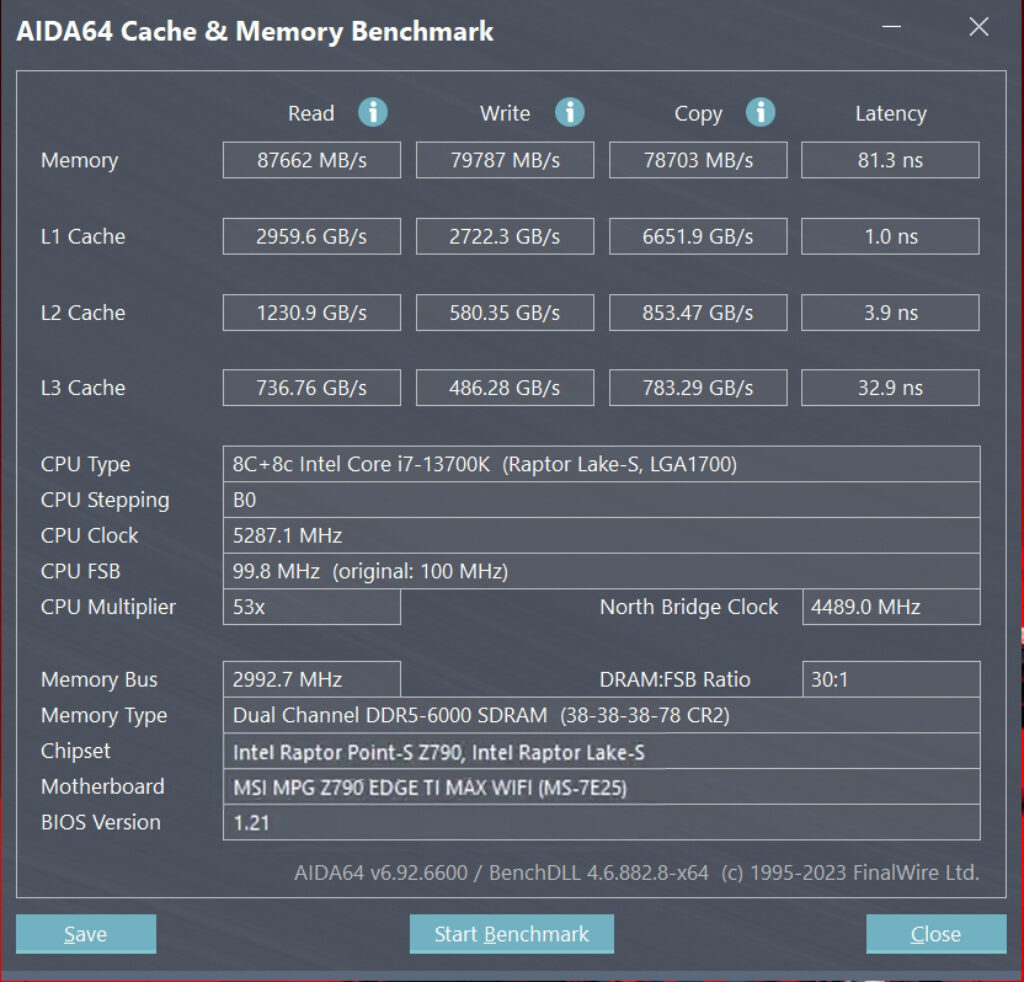
First, let’s test the 6000 MHz (Profile 2) in XMP mode. The timing is set to 38-38-38-78. At this configuration, the reading speed reaches 87,662MB/s, and the writing speed is 79,787MB/s. The copy speed registers at 78,703MB/s, with latency dropping to 81.3ns.

After setting the manual overclock to 6800 MHz, the timing is set to 36-47-47-84, and the read and write performance saw significant improvements, reaching 98.208 MB/s and 85,508 MB/s, respectively, with a latency of 79.8ns. For most gamers, 6800 MHz offers a stable and high-performance option, ensuring a smooth and responsive gaming experience.

Then the XMP was changed to 7600 MHz (Profile 1) for testing, and the results were even more surprising. The reading speed reached 118.03 GB/s, the writing speed was 115.08 GB/s, the copying speed was 113.01 GB/s, and the latency dropped to 58.2 ns. Comparing the test results, it is clear that when this pair of memories runs at 7600 MHz, the reading, writing, and copying performance greatly improves, and the latency further reduces. There is basically no pressure when running software and playing games.

Don’t think that 7600 MHz is the limit of T-FORCE XTREEM DDR5 memory. After pushing the manual overclock to 8000 MHz, performance sees a significant boost, with read speeds reaching 127.89 GB/s and write speeds hitting 127.17 GB/s. Copy speeds also peak at 120,42 GB/s, while latency drops to 53.9ns.
During the AIDA64 test, enabling XMP mode rather than sticking with default settings leads to significant enhancements in various performance metrics. Memory read, write, and copy speeds all show substantial improvements, accompanied by a notable reduction in latency. These findings highlight the exceptional performance capabilities of the T-FORCE XTREEM DDR5-7600 MHz.
The T-FORCE XTREEM DDR5-7600 memory module demonstrates impressive performance across various configurations. At its default frequency of 5600 MHz, it delivers solid read, write, and copy speeds, along with commendable latency. Enabling XMP mode and testing at 6000 MHz and 7600 MHz frequencies significantly enhances performance, with noticeable improvements in speed and reduced latency. Further manual overclocking to 8000 MHz pushes these capabilities even further, achieving exceptional read, write, and copy speeds with remarkably low latency. Overall, the T-FORCE XTREEM DDR5-7600 MHz is an outstanding choice for users seeking top-tier memory performance.
Use Experience
In terms of stability, after two weeks of testing, the T-FORCE XTREEM DDR5-7600 memory proved to be highly reliable. Throughout this period, there were no blue screen crashes, whether during intensive AAA gaming sessions or regular daily use. The overclocking stability was equally impressive. In the Cyberpunk 2077 game benchmark test, running at a 4K resolution with high image quality settings, the average frame rate reached a solid 80fps, demonstrating the memory’s robust performance.
Moreover, other demanding AAA titles like “Red Dead Redemption 2,” “Death Stranding,” and “Elden Ring” also ran seamlessly at 4K high-definition settings. Each of these games maintained an average frame rate of over 80 fps, showcasing the T-FORCE XTREEM DDR5-7600’s ability to handle graphically intensive tasks without a hitch. The consistency in performance across various high-load scenarios underscores the reliability of this memory module.

Overall, the T-FORCE XTREEM DDR5-7600’s capacity to sustain stable performance during long-term high-load operation is commendable. It provides a robust solution for gamers and power users seeking both stability and high performance in their systems. The absence of crashes and the smooth gameplay experience at 4K resolution highlight the module’s excellence, making it a top choice for those demanding the best from their hardware.







